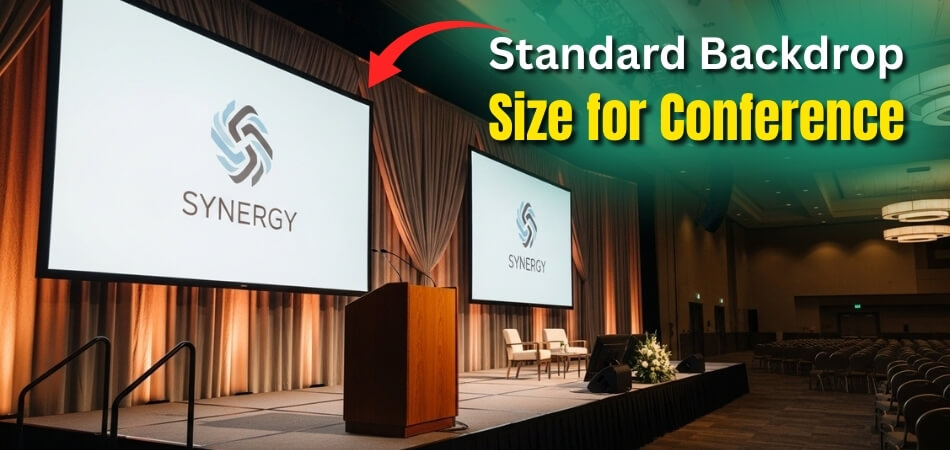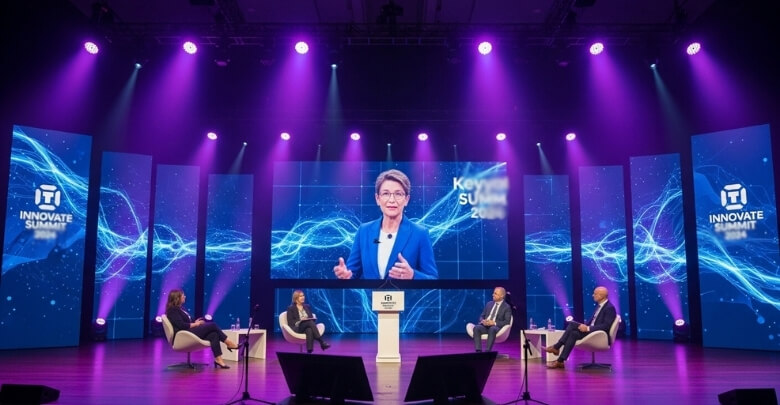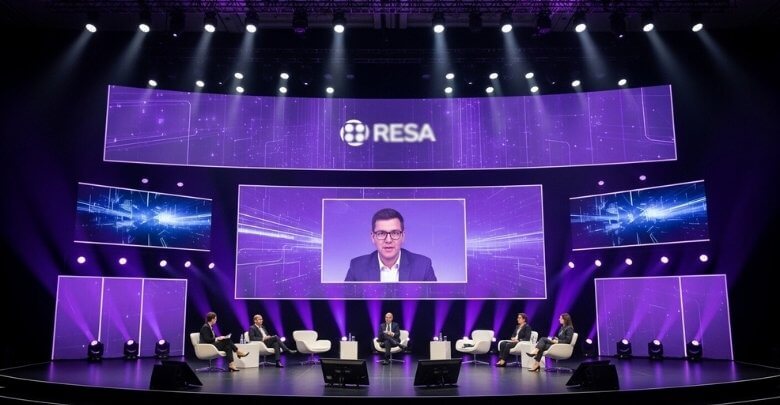Planning a conference involves many details, from stage setup to lighting, but one element that instantly defines the atmosphere is the backdrop. It’s more than decoration; it frames your speakers, strengthens your branding, and makes every photo look professional. That’s why many organizers start by asking the same essential question: What Is the Standard Backdrop Size for Conference?
In most cases, the standard backdrop sizes are 6.5ft × 10ft, 8ft × 10ft, and 10ft × 10ft. These dimensions are practical, widely used, and suitable for most event setups, giving you a balanced mix of visibility and manageability without overwhelming the stage or audience.
Of course, the right backdrop for your event depends on your venue, audience size, and branding goals. Keep reading to discover how to choose the perfect size, explore practical tips, and learn about other key details that make your backdrop stand out.
What Is the Standard Backdrop Size for Conference?
Choosing the right backdrop size for a conference can feel tricky, but it doesn’t have to be. In most cases, standard sizes like 6.5ft × 10ft, 8ft × 10ft, and 10ft × 10ft work well. These sizes are practical, easy to set up, and give enough space for branding without overwhelming the stage. Think of them as reliable go-to dimensions for most conferences, whether it’s a business seminar or a panel discussion.

That said, there isn’t one size that fits every event. The “standard” depends on how big your stage is, how many people will be standing in front of it, and how the audience will view it. A small workshop might only need a modest 6.5ft × 10ft backdrop, while a large venue with cameras recording the session may call for something much bigger.
Now, let’s look at the key factors that influence the right backdrop size for your event.
Venue Size
Backdrop size should always be proportionate to the stage. A good rule is to keep it around 60–80% of the stage width. This keeps the stage balanced, avoids awkward empty spaces, and creates a professional look without overshadowing other elements.
Number of Attendees
The size of the audience affects visibility. For larger crowds, a bigger backdrop ensures logos and visuals remain clear, even for those sitting at the back. In smaller groups, a compact backdrop works fine and can help maintain a closer, more personal atmosphere.
Event Type
This kind of event makes a big difference. A large-scale conference with VIP guests or media coverage benefits from a bigger, eye-catching backdrop. Smaller or training-style events usually look better with modest backdrops that focus more on clarity and function rather than grandeur.
Branding Goals
If your backdrop needs to showcase multiple logos, sponsor names, or key messages, you’ll want more space to keep everything clear and uncluttered. A larger backdrop provides more room for design flexibility, ensuring your branding looks professional and doesn’t feel squeezed or overwhelming.
Budget
Bigger backdrops usually cost more to print, transport, and set up. If your budget is limited, choose a smaller size and focus on smart design choices, like placing logos strategically or using high-quality print. A well-designed, smaller backdrop can still make a strong impact.
There isn’t a single “perfect” backdrop size for every conference, but knowing the common standards and matching them with your event’s needs makes the decision much easier. Whether it’s a local event or a large international conference in Canada, the USA, or the UK, always check the venue, the audience, and your branding requirements before finalizing. When chosen well, the backdrop doesn’t just decorate the stage; it ties your whole event together and leaves a lasting impression.
Standard Conference Backdrop Sizes
When planning a conference, one of the first questions people ask is about the right backdrop size. The truth is, there are a few common dimensions that work well for most events, but the choice depends on how you’ll use them. Let’s break it down so you can quickly pick what suits your setup best.
- 6.5ft × 10ft – A compact size that works great for small workshops, training sessions, or intimate gatherings. It’s easy to install and still gives enough room for simple branding or speaker visibility without crowding the stage.
- 8ft × 10ft – The most versatile and widely used option. Perfect for mid-sized conferences, panels, or seminars, this size balances visibility, branding space, and practicality. It’s a safe choice for most professional events.
- 10ft × 10ft – Ideal for larger conferences or high-attendance events where a strong stage presence is needed. This backdrop size ensures logos, graphics, and speakers stand out clearly, even from the back rows.
Quick Reference Table
| Backdrop Size | Best For | Audience Range | Notes |
| 6.5ft × 10ft | Small workshops, intimate talks | Up to 50 people | Compact, simple branding |
| 8ft × 10ft | Mid-sized conferences, panels | 50–200 people | Most common and versatile |
| 10ft × 10ft | Large conferences, plenary sessions | 200+ people | Strong visibility for bigger stages |
| 12–20ft wide × 8ft high | Group photo walls or wide plenary stages | 200+ people | Often, modular or LED panels for flexibility |
These three backdrop sizes cover the majority of conference needs, giving you flexible choices whether your event is small, mid-sized, or large. Once you know your audience and stage size, choosing the right one becomes much simpler.
Importance of Backdrop in Conference
Every conference stage has a story to tell, and the backdrop is often the first thing people notice. It does more than just sit behind the speakers; it frames the entire mood of the event and connects directly to other details, such as designing a stage for a conference, where balance and structure really matter. A well-chosen backdrop can add both professionalism and personality to your conference. Let’s take a look at why it really matters.
Credibility
A professional-looking backdrop sets the tone for the entire conference. When attendees walk in, the first impression matters, and a neat, well-designed backdrop communicates that the event is serious, well-prepared, and worth their time. It builds instant trust between the organizers and the participants.
Branding
Conferences often bring together different audiences, and the backdrop is one of the best tools for reinforcing identity. By displaying your logo, tagline, or sponsor names, it keep your brand visible throughout. This constant presence reminds attendees who is behind the event and strengthens recognition.
Photography
Photos and videos taken during a conference are often used later for promotions, social media, or reports. A backdrop ensures that every shot looks polished and consistent. Instead of random walls or clutter in the background, the branding stays clear, helping your event remain memorable long after it ends.
Attention
A backdrop does more than decorate the stage; it helps remove distractions. Without it, the audience might focus on whatever is behind the speakers. With a clean and consistent backdrop, eyes stay directed toward the presenters, ensuring the message gets across without background noise pulling people away.
Focus
The backdrop works like a frame for the entire stage. It keeps all attention where it belongs, on the speakers and the content being shared. Cutting out unnecessary visual clutter creates an environment that supports learning, listening, and engagement, which is exactly what conferences are meant for.
While it may seem like just a background detail, the backdrop plays a big role in shaping how your conference is remembered. Choosing the right one ensures your event stands out for all the right reasons.
Ceiling Height & Camera Framing
One detail that often gets overlooked when setting up a backdrop is how it fits within the ceiling space and the camera’s view. These two elements may sound technical, but they’re actually what determine how professional your stage will look in person and on screen. To understand this better, let’s go step by step and see why size and framing matter.
Why 8ft Is the Norm
Most conference backdrops are built around 8 feet in height. This height works well because it clears the average person’s head with enough space above, without running into lighting rigs or ceiling fixtures. It also ensures that branding, logos, and visuals stay fully visible, both to the audience in the room and to cameras recording the event. If you go much taller, you risk hitting ceiling restrictions; much shorter, and it feels cramped or cut off.
Camera Framing Example
Think about how a camera captures the stage. If a wide-angle lens is used from 15 feet away, and the field of view covers about 14 feet horizontally, then your backdrop should be at least 14 feet wide to fill the frame without leaving empty walls on either side. On the other hand, for a narrower frame with just one or two speakers, a backdrop around 8–10 feet wide would look balanced without wasting space.
Matching backdrop size with ceiling height and camera framing ensures everything looks clean and professional, both on stage and in photos or recordings. When these two details align, the backdrop truly enhances your conference instead of becoming a distraction.
Logo Tile & Step-and-Repeat Guidelines
When it comes to conference backdrops, step-and-repeat designs are one of the most common choices. They not only look professional but also guarantee that your brand shows up in every photo. The trick is getting the logo sizing and placement right so the backdrop looks neat and effective. Here’s how to approach it in simple steps.
- Logo Sizing Matters: Square logos usually work best between 5–8 inches wide, while rectangular logos look clearer when placed at about 9–11 inches wide. This sizing keeps the logos readable in person and sharp in photos without overwhelming the backdrop.
- Repeats Per Photo: Ideally, every picture taken in front of the backdrop should show at least 2–4 full logos. This way, no matter where someone stands, your branding appears in the frame. Too many logos close together can feel cluttered, but too few can leave empty gaps.
- Backdrop Size Sweet Spot: For step-and-repeat backdrops, the most practical sizes are 8×8 feet or 8×10 feet. These dimensions provide enough surface area for clear logo repetition while fitting comfortably in most venues. They’re large enough for branding impact but manageable in setup and cost.
Step-and-repeat backdrops are simple yet powerful branding tools. By choosing the right logo size, keeping the right number of repeats, and sticking to balanced dimensions, you ensure your backdrop works just as hard as your speakers in leaving a lasting impression.
Cost, Setup & Shipping Cheatsheet
One thing that conference planners often worry about is how much effort and money it takes to manage a backdrop. While prices can change depending on materials and printing, it’s easier to think in ranges like small, medium, and large, rather than specific numbers. Knowing this helps you plan smarter without getting lost in the details. Let’s walk through the basics so you know what to expect before confirming your order.
Small Backdrops
These are sizes like 6.5×10 ft. They are affordable, light, and simple to move around. In most cases, two people can set them up in less than an hour. They fold or roll easily, making them inexpensive to ship and easy to store between events.
Medium Backdrops
An 8×10 ft backdrop is the most common conference choice. Costs are moderate since it requires more material and structure, but it still fits in standard shipping cartons or lightweight cases. Transport is manageable, and with two people, setup is straightforward. This size offers the best balance between impact and convenience.
Large Backdrops
Anything from 10×10 ft up to 20 ft wide falls into this range. Costs increase with material, printing, and heavier support frames. They are bulkier to ship and may require professional delivery or larger cases. Setup is still possible with two people, but in some cases, extra help makes things smoother.
Thinking in terms of size categories helps you plan your budget and logistics more clearly. Whether you need something small, standard, or large-scale, knowing the effort, shipping, and setup involved saves you from surprises on event day.
Essential Tips for Choosing the Right Backdrop for Conference
Picking the right backdrop is not just about measurements; it’s about making sure it matches the tone, scale, and purpose of your event. A few simple points can guide your decision and help you avoid costly mistakes. Let’s go over the essentials step by step.
- Define Your Goals: Ask yourself what the backdrop should achieve. Is it mainly for branding, for creating a professional stage look, or for photos and videos? Once the purpose is clear, you can choose a design and size that directly supports that goal.
- Check the Venue Size: Always measure the stage and the available ceiling height before ordering. A backdrop that’s too big can overwhelm the room, while one that’s too small will look out of place. Matching it to the venue ensures a balanced, polished appearance.
- Consider Audience Size: Larger audiences need a bigger backdrop so that branding and visuals are still visible at a distance. For smaller groups, a more compact backdrop works better and creates a sense of closeness without wasting space or money.
- Think About Camera Framing: If your event will be photographed or recorded, the backdrop should fill the camera’s frame neatly. Too narrow, and empty walls may appear in the shot. Too wide, and it may look awkward. Balanced framing is key for professional-looking coverage.
- Prioritize Branding: If sponsor logos or your organization’s identity are part of the design, make sure the backdrop offers enough space to display them clearly. A cluttered layout makes the event look less professional, while clean spacing strengthens your message.
- Choose the Right Colors: Pick shades that match your event theme and room setting. Neutral or brand-matching tones usually work best. Considering the best color choices for a conference room helps create harmony between the backdrop and the overall space.
- Budget Wisely: Bigger isn’t always better. Larger backdrops cost more to print, ship, and install. Decide how much you want to spend and focus on design quality within that budget. A smaller but well-planned backdrop can be just as impactful.
By keeping these simple points in mind, you’ll avoid common mistakes and end up with a backdrop that feels just right. The best choice is the one that fits your venue, your goals, and your budget in perfect balance.
Frequently Asked Questions
After learning about backdrop sizes and setup, many people still have a few practical questions in mind. Here are some extra details that often come up when event planners or organizers are finalizing their backdrop plans.
Can a Backdrop Be Reused for Multiple Conferences?
Yes, backdrops can be reused if they’re made from durable materials like fabric or vinyl. You’ll just need to store them carefully to avoid wrinkles or damage. Reusing helps save costs across several events.
What Colors Work Best for Conference Backdrops?
Neutral shades like white, gray, or navy are popular because they don’t distract from speakers. Brighter colors can be used if they match your brand theme. Always avoid overly busy designs that compete with text or logos.
Do Backdrops Always Need a Frame?
Not always, but frames make them more stable and professional-looking. Some venues allow you to mount backdrops on walls, but a frame keeps the fabric stretched tight. This prevents wrinkles and helps with photography quality.
How Do I Store a Backdrop After an Event?
Roll the backdrop instead of folding it to avoid deep creases. Keep it in a dry, cool place inside a protective bag or case. Proper storage means it’ll be ready to use again without extra preparation.
Can Lighting Affect the Backdrop Appearance?
Yes, lighting can completely change how a backdrop looks. Too much light can cause glare, while poor lighting makes logos fade into the background. Always test stage lighting against the backdrop before the event begins.
Should I Add Text Along With Logos on the Backdrop?
It’s best to keep text minimal, focusing mainly on your event name or theme. Too much writing clutters the design and becomes unreadable from a distance. Clear logos and one strong headline usually work best.
Are Digital Backdrops a Good Option?
Digital backdrops, like LED screens, can be a smart choice for modern conferences. They let you change visuals during the event and update sponsor logos instantly. The main downside is the higher cost compared to print.
Concluding Words
Deciding on the right backdrop can feel like a small detail, but it sets the tone for the entire event. From photos to stage presence, it influences how professional and polished your conference will look to everyone attending.
When asked, What Is the Standard Backdrop Size for Conference, the common answer is 6.5ft × 10ft, 8ft × 10ft, or 10ft × 10ft. These sizes are versatile, practical, and widely used, making them suitable for different types of conferences and venues.
At the end of the day, the best choice depends on your space, your audience, and your branding needs. By keeping these factors in mind, you can select a backdrop that enhances the stage, improves visibility, and ensures your event leaves a lasting impression.







